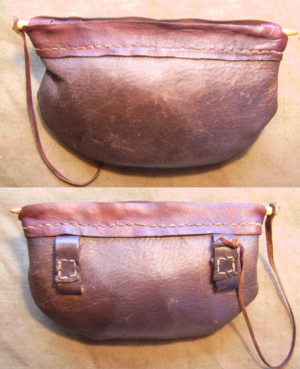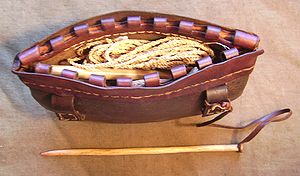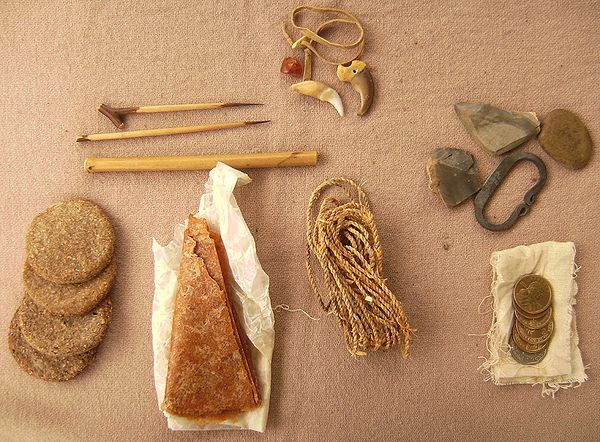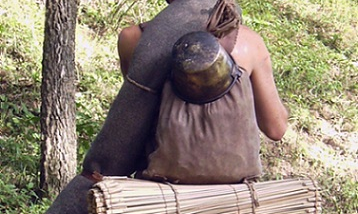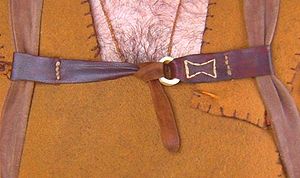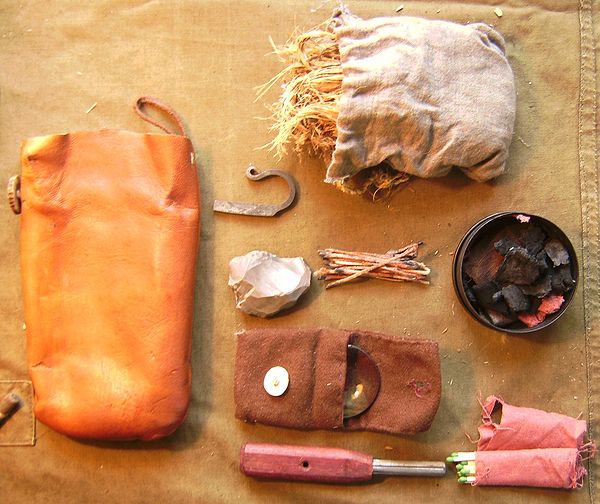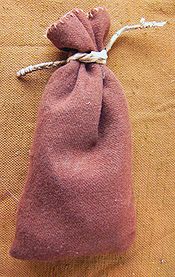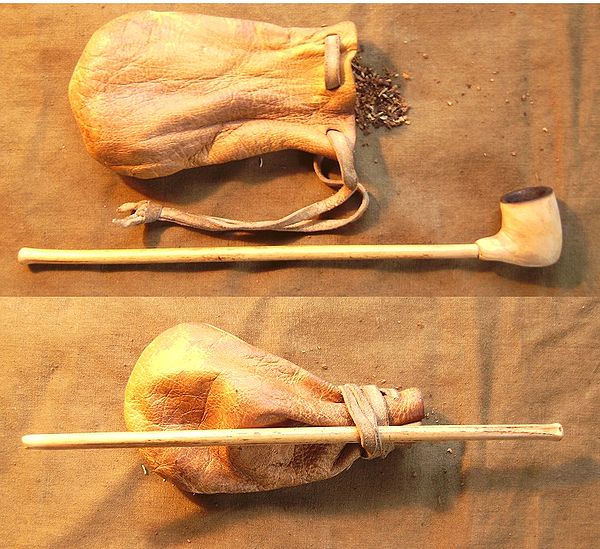Áistan: Hard kit
“…Beorn did not appear to care for [gold, silver, jewels, smith-craft]: there were no things of gold or silver in his hall, and few save the knives were made of metal at all.” (TH 126).
With this quote in mind, I endeavored to make as much of my gear metal-free as possible.
First-line gear These first two items are always on my person—even when sleeping.
Zip bag
This pouch is my interpretation of a bag found in one of the Danish oak coffin burials (Hvidegard). I didn’t want anything that would be hanging from my belt on a drawstring, or flapping around and opening easily, and this bag has legitimate historical pedigree. The original was closed with a bronze rod, but for Beorning purposes I switch it out for a straightened stick of hazel.
My belt pouch contains: o four biscuits of ‘cram’ (spelt and acorn flour and honey, mostly); a sheet of fruit leather in waxed paper; large hank of fine lime cordage; firesteel and flints; ‘whetstone’ from a creek; several spare locust thorn ‘pins’; wingbone ‘straw’ for drinking (double use as a fire bellows); a pair of simple bronze tweezers; two small sheets of birchbark; a candle stub wrapped in linen, secured by a piece of mammoth ivory on buckskin thong.
Belt knife
My dad and I forged my knife (based on Dutch and Danish Bronze Age pattern, but in 19th century spring steel), and I carved the deer antler handle myself, painted with ochre and eggyolk. While it may seem roundabout to copy a historically-bronze knife in iron, “a few fully iron knives identical to the bronze examples are known”! (Butler, Arnoldussen, & Steegstra, Single-edged socketed Urnfield knives in the Netherlands and Western Europe. University of Groningen, 2012).
Pack
The knapsack I use for this persona is a heavy linen copy of a 1940s Soviet ‘vyeshmeshok’. It’s basically a pillowcase with a drawstring at one end and a big U-shaped single strap at the other; this forms the two shoulder straps by making a lark’s head ‘knot’ around the cinched neck of the bag. So, why use a 20th century design for a persona ostensibly 6,000 years in the past? The Middle-earth answer is something to do with Beorn and Russia both being associated with bears (in fact, Beorn’s name was originally ‘Medwed’—which is essentially the Russian word for bear, ‘medved’. However, the practical answer is merely that I know it’s an extremely simple, tried-and-true (if it can survive the Eastern Front, it can survive anything), design that can take a beating and is user-serviceable. Besides, making it brown instead of olive drab instantly makes it look *not* military.
The pack’s drawstring is made of deer sinew, and is actually a spare string for my shortbow!
After too many days coming home sore after hiking with a fully-loaded pack, I made up some felted pads to cushion my shoulders. The ‘ancient’ sternum strap is goatskin leather and a ring of deer bone—inspired by similar rings found in Bronze Age Britain—for a ‘buckle’.
What's In the Pack?
Like the old Boy Scout handbook says, “a scout’s pack is a bag of bags!”, and mine is no different. (Protip: most of the linen (and some of the wool) which I use for small bags and such comes from cannibalized garments I get for supercheap at the thrift store. For example, you can get a yard or more of heavy earthtone 100% linen from a woman’s jumper!)
Fire kit
While I do keep a steel striker and some flint chunks in my belt pouch, my main fire kit stays in the pack, in this bag I made of goatskin leather, closed with a deer antler button It contains: a spare steel striker (from my blacksmithing days) + a spare chunk of flint (from the source); charred linen or wood and some once-dipped candle wicks in a round tin (about $3); a linen bag of tinder (a bird’s nest (literally!), cedar bark, tow, ‘fatwood’ slivers, and birchbark); a ‘burning glass’ ($3) in a flannel-lined wool pouch.
To be used only for emergencies, I carry a few matches (which were known to Hobbits, but were never adopted by dwarves). I also have a couple of beeswax candles stowed away somewhere else in my pack.
While on the trail, I always keep my eyes peeled for tinder materials, which I can tuck into my tunic’s front section to keep them dry until I make camp.
Repair
Even over the Edge of the Wild, an adventurer still needs to be able to maintain his gear. This wool bag contains my sewing kit:: linen (1-ply natural ($5), 3-ply natural); a cane needle case + needles; beeswax for waxing thread; an antique leather awl (gift from Master) with cane cover; a cane case of fine brass pins; and scraps of linen, wool, buckskin and thongs for laces. The one item in my sewing kit I cannot reliably document are my pair of small ‘Chinese’ scissors ($3). Scissors appear nowhere in Tolkien, but we know hobbits (at least) wore tailored clothes and so likely would have had them. I imagine that simple, functional tools like these could be of dwarvish make?
At the bottom of my pack I keep a tin of 1:1 rendered beef tallow/beeswax for ‘waterproofing’.
Hygiene
To keep myself (relatively) clean while out on an adventure, I have a limited hygiene kit.
This linen bag holds a handmade wooden comb, a natural-bristle wooden toothbrush (with birchbark cover), a bar of plain lye soap, and two handwoven washcloths from ‘The Blue Goose’. Although soap was known in the Shire (and I suppose possibly traded eastwards?), there’s no reason it couldn’t be made at home…the ingredients and process are simple enough.
When I’m out and about, I like to pick and keep a few fresh leaves of Mullein tucked in my tunic (nothing even comes close for wiping one’s arse in the bush, especially if you find some in the morning when it’s still damp with dew: Nature’s wet-wipes!)
Along the same lines, I keep a deer’s scapula in my pack, which does tolerably well as a tool for digging ‘cat-holes’…because while Tolkien’s heroes may never have to poo in the woods, I do.
Miscellaneous gear
My smoking setup is quite simple: when I head out on an adventure, I cut a slice of apple and loosely wrap it in waxed paper. I put this at the bottom of my tobacco pouch, and then add as much pipe-weed as I think I’ll use on the trip. (The apple acts as a humidor, adding moisture to the flakes of tobacco for smoother smoking.) Lastly I put in my pipe bowl (carved last Yule from applewood). I wrap the pouch’s drawstring around the neck and slip in the pipe’s rivercane stem. No need for matches (which probably weren't known to Beornings), I only light my pipe with twigs around the fire, or with my burning glass on very sunny days.
I keep a small bundle of non-unraveling cordage—greased buckskin thongs—in the bottom of my pack. As any woodsman worth his salt should certainly know which natural resources could be utilized for making cordage, I often gather raw materials (nettle, milkweed, &c) as I go.
While 18th century trekkers carry pocket bibles or such reading materials, my ‘comfort/luxury item’ is a leatherbound notebook. It contains poetry from Middle-earth and later Ages, sketches of footprints and tracking info, an annotated map of my stretch of the Ohio, and a river mileage chart.
While 18th century trekkers carry pocket bibles or such reading materials, my ‘comfort item’ is a leatherbound journal of poetry from Middle-earth and later Ages, semi-illustrated with heraldry and an annotated map of my stretch of the great river Ohio.
